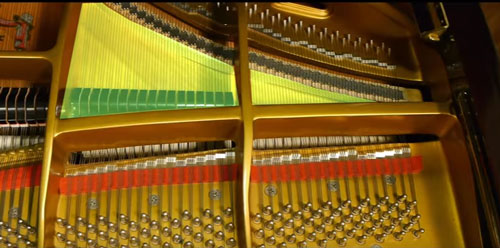This is a very interesting topic and one that is relevant to the reality of modern day piano building. There was a time when piano actions were made entirely of wood parts but with advances in technology come newer and cheaper alternatives. Today we are going to discuss whether or not plastic actions are as good – or better – than their wooden counterparts.
If you’ve ever looked at a piano action you notice the sheer complexity of it – there are literally thousands of parts. For centuries, piano actions were made out of wood. As time went on and plastics became better, some piano companies began experimenting with putting plastic into their actions in order to cut down on costs.
Early attempts at incorporating plastic parts in actions in the 1950s and 1960s – were wrought with problems because the plastic would become brittle and break over time. These piano actions can be a nightmare to work on and generally should be avoided.
In recent years plastics have come a long way. In fact, Wessel, Nickel & Gross have invented a carbon fiber action that has no wooden parts at all! These actions play differently from traditional actions and are very high quality and can be found in new Mason & Hamlin pianos.
Generally, companies started to rely on plastic parts in their actions because they are easier and cheaper to mass produce. This is not technically a bad thing but most of the companies that are cutting costs are using plastic for some parts of their actions and not all of them. This can cause problems because wood will expand and contract with changes in the weather and room climate – yet plastic will not. This can create problems in some situations with notes hanging up. If you live in a place with widely different temperatures sometimes an all wood or all synthetic action will be a better choice for you.
Another issue with plastic actions are new designs and technologies that require new skill sets to work with. A wood action has been the standard for so long that any reputable piano technician should be able to work with them. When it comes to plastic actions or carbon fiber actions, you might have to search for someone who is familiar with those particular actions and possibly have access to spare parts if necessary.
There are many great companies like Kawai and Mason & Hamlin that utilize plastic and synthetics in their piano actions and they have had great results. However, the vast majority of great pianos in the world still utilize wooden actions – such as Hamburg Steinway and Bösendorfer (which both use Renner Actions made entirely out of wood).
More than anything, it’s finding the right piano and action for you. You should certainly be wary of actions that mix wood and plastic in more extreme climates but overall there are new technologies available that are worth your consideration.
Thanks again for joining me Robert Estrin Robert@LivingPianos.com (949) 244-3729




















